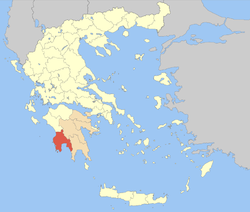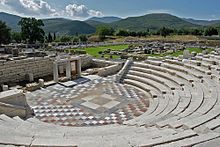Messenia
This article may require cleanup to meet Wikipedia's quality standards. (March 2011) |
Messenia
Περιφερειακή ενότητα Μεσσηνίας | |
|---|---|
 Municipalities (dimi) of Messenia, 2010:
| |
 Messenia within Greece | |
| Coordinates: 37°10′N 22°0′E / 37.167°N 22.000°ECoordinates: 37°10′N 22°0′E / 37.167°N 22.000°E | |
| Country | Greece |
| Region | Peloponnese |
| Capital | Kalamata |
| Area | |
| • Total | 2,991 km2 (1,155 sq mi) |
| Population (2011) | |
| • Total | 159,954 |
| • Density | 53/km2 (140/sq mi) |
| Time zone | UTC+2 (EET) |
| • Summer (DST) | UTC+3 (EEST) |
| Postal codes | 24x xx |
| Area codes | 272x0, 276x0 |
| ISO 3166 code | GR-17 |
| Car plates | ΚΜ |




Messenia or Messinia (/məˈsiːniə/ mə-SEE-nee-ə; Greek: Μεσσηνία [mesiˈni.a]) is a regional unit (perifereiaki enotita) in the southwestern part of the Peloponnese region, in Greece. Until the implementation of the Kallikratis plan on 1 January 2011,[1] Messenia was a prefecture (nomos) covering the same territory. The capital and largest city of Messenia is Kalamata.
Geography[]
Physical[]
Messenia borders on Elis to the north, Arcadia to the northeast, and Laconia to the southeast. The Ionian Sea lies to the west, and the Gulf of Messinia to the south. The most important mountain ranges are the Taygetus in the east, the in the northwest and the in the southwest. The main rivers are the Neda in the north and the Pamisos in central Messenia.
Off the south coast of the southwesternmost point of Messenia lie the islands. The largest of these are Sapientza, Schiza and Venetiko. The small island Sphacteria closes off the bay of Pylos. All these islands are virtually uninhabited.
Climate may vary, in the lowlands, temperatures are a bit warmer than Athens. Snow is not common during winter months except for the mountains, especially the Taygetus. Rain and clouds are common inland.
Political[]
Organization of Messenia[]
Before the 2010 reorganization, Messenia was a nomos (prefecture) containing 29 dimoi (municipalities) and 2 koinotites (communities). Since 2010, Messenia has been a perifereiake enoteta (regional unit) containing only 6 municipalities, but with the same population, as it did not change area in the reorganization. Some 25 municipalities and communities were incorporated politically into the other 6 according to the table below, becoming municipal units.[1]
| Municipality | Municipal unit | Seat |
|---|---|---|
| Kalamata | Kalamata | Kalamata |
| Aris | ||
| Arfara | ||
| Thouria | ||
| Messene (Messini) |
Messene | Messene |
| Aipeia | ||
| Androusa | ||
| Aristomenis | ||
| Voufrades | ||
| Petalidi | ||
| Meligalas | ||
| Andania | ||
| Dorio | ||
| Eira | ||
| Meligalas | ||
| Pylos-Nestoras | Pylos | Pylos |
| Koroni | ||
| Methoni | ||
| Nestoras | ||
| Chiliochoria | ||
| Trifylia | Kyparissia | Kyparissia |
| Aetos | ||
| Gargalianoi | ||
| Filiatra | ||
| Tripyla | ||
| West Mani (Dytiki Mani) |
Avia | Kardamyli |
| Lefktro |
Provinces[]
The prefecture of Messenia was previously subdivided into four provinces (Greek: επαρχίες, "eparchies") :
- Province of Kalamon - Kalamata
- Province of Messini - Messine
- Province of Pylia - Pylos
- Province of - Kyparissia
Like all provinces of Greece, they were abolished after the 2006 local elections, in line with Law 2539/1997, as part of the "Kapodistrias reform". Some of the enlarged municipalities (demoi) created in 2011 have a territory similar to the former provinces.
Population[]
| Year | Population |
|---|---|
| 1991 | 167,292 |
| 2001 | 172,875 |
| 2011 | 159,954 |
The main cities and towns of Messenia are (ranked by 2011 census population):
- Kalamata 54,567
- Filiatra 6,791
- Messini 6,287
- Kyparissia 5,784
- Gargalianoi 5,569
- Chora (Nestoras) 3,498
- Pylos 2,767
Economy[]

The economy of Messenia is primarily based on agricultural production although in recent years efforts are being made toward the development of activities in other sectors such as tourism.
Main agricultural products are olive oil, Kalamata table olives, figs, and black raisins (sultanas). The variety of agricultural products is complemented by a small amount of stockbreeding products (beef, milk, sfela cheese, honey) and fish from the Gulf of Messenia.
The tourist development observed is mainly attributable to the promotion of important archaeological sites, such as the Palace of Nestor, Ancient Messene, and the Venetian castles of Pylos, Koroni, and Kalamata, as well as to the beauty of the landscape. Another key factor for Messenia's economy is a location on the border between Pylos and Trifylia, comprising several eco-friendly luxury resorts and golf courses, which is Greece’s biggest tourist development.[2]
There are many small- and medium-size firms involved in the processing and standardization of agricultural products as well as a number of enterprises devoted to wood processing, furniture manufacturing, and metal construction. The Karelia tobacco company is based in Kalamata.
Transport[]
The main airport in Messenia is Kalamata International Airport (KLX).
The main highways in Messenia are:
- Greek National Road 7 (Corinth - Tripoli - Kalamata)
- Greek National Road 9 (Patras - Pyrgos - Kyparissia - Pylos)
- Greek National Road 82 (Pylos - Kalamata - Sparti)
The main railways in Messenia (meter gauge) are:
- Corinth - Argos - Tripoli - Zevgolateio - Kalamata
- Patras - Pyrgos - Kalo Nero - Kyparissia
- Kalo Nero - Zevgolateio
Communications[]
Television[]
- , (Southern Greece Television)
- ,
History[]
Ancient period[]

Messenia is mentioned in the oldest work of European literature, the Iliad.[citation needed] The name undoubtedly goes back to at least the Bronze Age, but its origins are lost in the world of mythology. The region was one of the largest that was conquered and enslaved as helots by ancient Sparta.
Medieval period[]
In the Middle Ages, Messinia shared the fortunes of the rest of the Peloponnese. Striking reminders of these conflicts are afforded by the extant ruins of the medieval strongholds of Kalamata, Coron (anc. Asine, mod. Korone), Modon (Methone) and Pylos. Messenia was a part of the Byzantine Empire.
Ottoman and Venetian period[]
Much of Messenia fell into the hands of the Ottoman Turks, a part of the area remained with the Venetian Republic. In 1534 a group of families, known as the 'Coroni', settled in Piana degli Albanesi in Sicily. They were Arvanites and Greeks from Koroni.
During the 1680s, the whole of Messenia was regained by the Venetian Republic in the Morean War, and formed part of the "Kingdom of the Morea" until recovered by the Ottomans in 1715. The Mani Peninsula, a part of modern Messenia, was autonomous from Turkish rule due to the fact that it had no harbors.
Modern period[]
Messenia became part of independent Greece as a result of the Greek War of Independence (1821-1832). The famous naval Battle of Navarino took place near present Pylos in 1827, and was a decisive victory for Greece and its allies. The population in the area of Kalamata and Messene increased from 30,000 before World War II up to nearly 80,000 in the present day.. Messenia suffered damage from the 2007 Greek forest fires.
See also[]
Notes[]
- ^ Jump up to: a b "ΦΕΚ A 87/2010, Kallikratis reform law text" (in Greek). Government Gazette.
- ^ Bloomberg webpage Archived 2015-09-16 at the Wayback Machine
Bibliography[]
- Hellenic Interior Ministry (18 March 2001). Δείτε τη Διοικητική Διαίρεση (in Greek). Hellenic Interior Ministry.. The previous Kapodistrias organization of all the communities in Greece. The populations are from the Census of 2001.
- Kontogiannis, N.D. "Settlements and countryside of Messinia during the late Middle Ages: the testimony of the fortifications," Byzantine and Modern Greek Studies, 34,1 (2010), 3-29.
- This article incorporates text from a publication now in the public domain: Chisholm, Hugh, ed. (1911). "Messinia". Encyclopædia Britannica (11th ed.). Cambridge University Press.
External links[]
 Media related to Messenia at Wikimedia Commons
Media related to Messenia at Wikimedia Commons
- Messenia
- Prefectures of Greece
- Regional units of Peloponnese (region)


